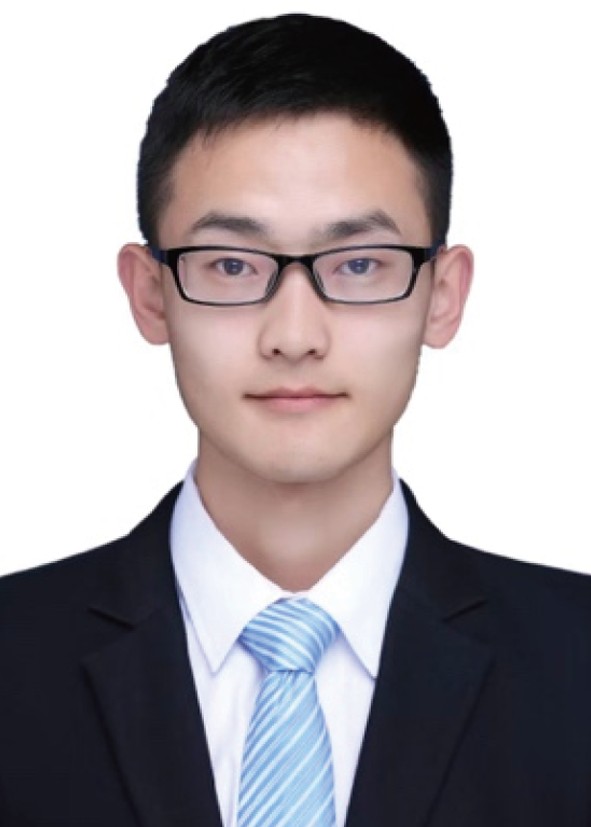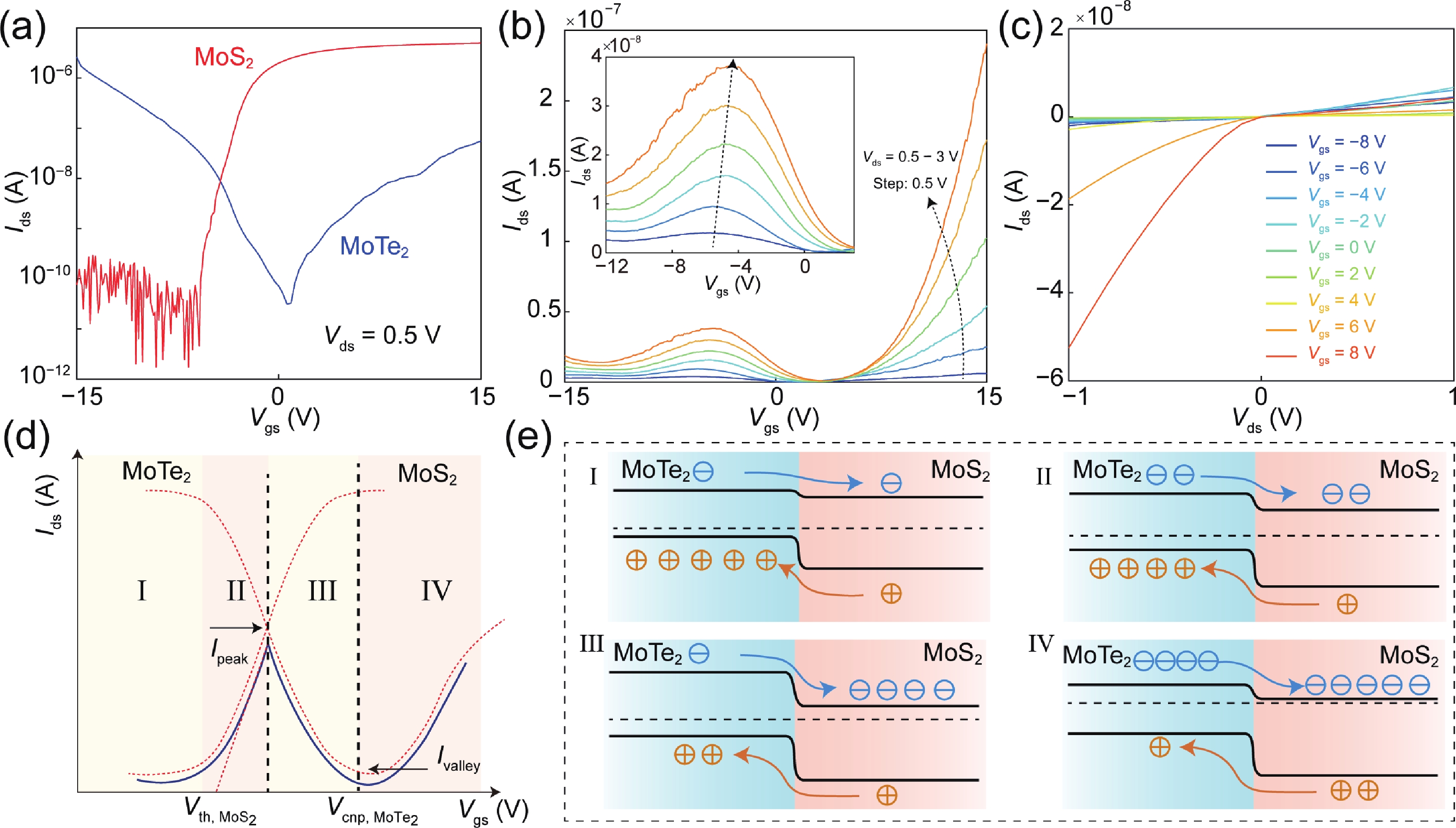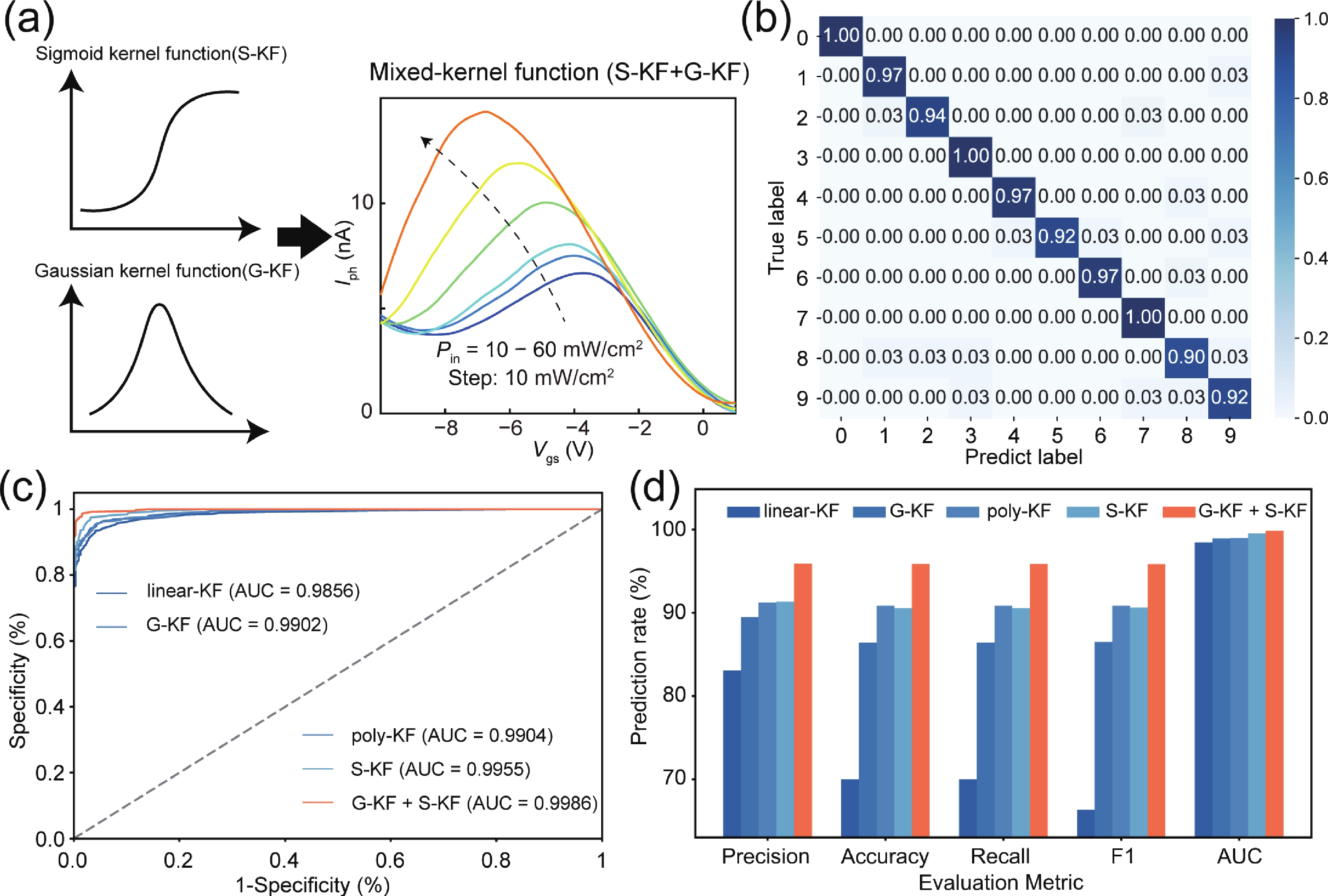| Citation: |
Xinyu Huang, Jiapeng Du, Langlang Xu, Lei Tong, Xiangxiang Yu, Lei Ye. Programmable mixed-kernel based on MoTe2/MoS2 heterojunction for support vector machine learning[J]. Journal of Semiconductors, 2026, In Press. doi: 10.1088/1674-4926/25070039
****
X Y Huang, J P Du, L L Xu, L Tong, X X Yu, and L Ye, Programmable mixed-kernel based on MoTe2/MoS2 heterojunction for support vector machine learning[J]. J. Semicond., 2026, 47(3), 032701 doi: 10.1088/1674-4926/25070039
|
Programmable mixed-kernel based on MoTe2/MoS2 heterojunction for support vector machine learning
DOI: 10.1088/1674-4926/25070039
CSTR: 32376.14.1674-4926.25070039
More Information-
Abstract
The von Neumann bottleneck in conventional computing architectures presents a significant challenge for data-intensive artificial intelligence applications. A promising approach involves designing specialized hardware with on-chip parameter tunability, which directly accelerates machine learning functions. This work demonstrates a continuously tunable mixed-kernel function physically realized within a van der Waals heterostructure. We designed and fabricated a MoTe2/MoS2 type-Ⅱ vertical heterojunction phototransistor, which exhibits a non-monotonic, Gaussian-like optoelectronic response owing to its unique interlayer charge transfer mechanism. This intrinsic physical behavior directly maps to a mixed-kernel function combining Gaussian and Sigmoid characteristics. Furthermore, the hardware kernel can be continuously modulated by in-situ tuning of external optical stimuli. The mixed-kernel exhibited exceptional performance, achieving precision, accuracy, and area under the curve (AUC) values of 95.8%, 96%, and 0.9986, respectively, significantly outperforming conventional kernels. By successfully embedding a complex, adaptable mathematical function into the intrinsic physical properties of a single device, this work pioneers a novel pathway toward next-generation, energy-efficient intelligent systems with hardware-level adaptability. -
References
[1] Merolla P A, Arthur J V, Alvarez-Icaza R, et al. A million spiking-neuron integrated circuit with a scalable communication network and interface. Science, 2014, 345(6197), 668 doi: 10.1126/science.1254642[2] Zou X Q, Xu S, Chen X M, et al. Breaking the von Neumann bottleneck: Architecture-level processing-in-memory technology. Sci China Inf Sci, 2021, 64(6), 160404 doi: 10.1007/s11432-020-3227-1[3] Noble W S. What is a support vector machine? Nat Biotechnol, 2006, 24(12), 1565 doi: 10.1038/nbt1206-1565[4] Mammone A, Turchi M, Cristianini N. Support vector machines. Wires Comput Stat, 2009, 1(3), 283 doi: 10.1002/wics.49[5] Liu Q Z, Chen C, Zhang Y, et al. Feature selection for support vector machines with RBF kernel. Artif Intell Rev, 2011, 36(2), 99 doi: 10.1007/s10462-011-9205-2[6] Liu Z L, Xu H B. Kernel parameter selection for support vector machine classification. J Algoritms Comput Technol, 2014, 8(2), 163 doi: 10.1260/1748-3018.8.2.163[7] Gold C, Sollich P. Model selection for support vector machine classification. Neurocomputing, 2003, 55(1-2), 221 doi: 10.1016/S0925-2312(03)00375-8[8] Boolchandani D, Ahmed A, Sahula V. Efficient kernel functions for support vector machine regression model for analog circuits’ performance evaluation. Analog Integr Circuits Signal Process, 2011, 66(1), 117 doi: 10.1007/s10470-010-9476-6[9] Huo Q, Song R J, Lei D Y, et al. Demonstration of 3D convolution kernel function based on 8-layer 3D vertical resistive random access memory. IEEE Electron Device Lett, 2020, 41(3), 497 doi: 10.1109/LED.2020.2970536[10] Zhou X C, Wang X D. A memory-efficient federated kernel support vector machine for edge devices. IEEE Trans Neural Netw Learn Syst, 2024, 35(12), 17359 doi: 10.1109/TNNLS.2023.3302802[11] Amari S, Wu S. Improving support vector machine classifiers by modifying kernel functions. Neural Netw, 1999, 12(6), 783 doi: 10.1016/S0893-6080(99)00032-5[12] Liu H F, Qin Y, Chen H Y, et al. Artificial neuronal devices based on emerging materials: Neuronal dynamics and applications. Adv Mater, 2023, 35(37), e2205047 doi: 10.1002/adma.202205047[13] Jafari A, Ganesan A, Thalisetty C S K, et al. SensorNet: A scalable and low-power deep convolutional neural network for multimodal data classification. IEEE Trans Circuits Syst I Regul Pap, 2019, 66(1), 274 doi: 10.1109/TCSI.2018.2848647[14] Yan X D, Qian J H, Ma J H, et al. Reconfigurable mixed-kernel heterojunction transistors for personalized support vector machine classification. Nat Electron, 2023, 6, 862 doi: 10.1038/s41928-023-01042-7[15] Liu H F, Wu J B, Ma J H, et al. A van der Waals interfacial junction transistor for reconfigurable fuzzy logic hardware. Nat Electron, 2024, 7, 876 doi: 10.1038/s41928-024-01256-3[16] Zhang X H, Peng B. The twisted two-dimensional ferroelectrics. J Semicond, 2023, 44(1), 011002 doi: 10.1088/1674-4926/44/1/011002[17] Liu Y, Huang Y, Duan X F. Van der waals integration before and beyond two-dimensional materials. Nature, 2019, 567(7748), 323 doi: 10.1038/s41586-019-1013-x[18] Xin K Y, Wang X G, Grove-Rasmussen K, et al. Twist-angle two-dimensional superlattices and their application in (opto)electronics. J Semicond, 2022, 43(1), 011001 doi: 10.1088/1674-4926/43/1/011001[19] Novoselov K S, Mishchenko A, Carvalho A, et al. 2D materials and van der waals heterostructures. Science, 2016, 353(6298), aac9439 doi: 10.1126/science.aac9439[20] Zhao S W, Shao G L, Han Z V, et al. Gate tunable spatial accumulation of valley-spin in chemical vapor deposition grown 40°-twisted bilayer WS2. J Semicond, 2023, 44(1), 012001 doi: 10.1088/1674-4926/44/1/012001[21] Gao H, Zhou H Y, Hao Y L, et al. Controllable growth of wafer-scale PdS and PdS2 nanofilms via chemical vapor deposition combined with an electron beam evaporation technique. J Semicond, 2023, 44(12), 122001 doi: 10.1088/1674-4926/44/12/122001[22] Liang J C, Hu Y, Ding L M, et al. 2D black arsenic phosphorous. J Semicond, 2024, 45(3), 030201 doi: 10.1088/1674-4926/45/3/030201[23] Huang X Y, Zhang L M, Tong L, et al. Manipulating exchange bias in 2D magnetic heterojunction for high-performance robust memory applications. Nat Commun, 2023, 14(1), 2190 doi: 10.1038/s41467-023-37918-7[24] Wang H Y, Song X Y, Li Z X, et al. Recent advances in two-dimensional photovoltaic devices. J Semicond, 2024, 45(5), 051701 doi: 10.1088/1674-4926/45/5/051701[25] Huang X Y, Han X, Dai Y Y, et al. Recent progress on fabrication and flat-band physics in 2D transition metal dichalcogenides moiré superlattices. J Semicond, 2023, 44(1), 011901 doi: 10.1088/1674-4926/44/1/011901[26] Kang K F, Li T X, Sohn E, et al. Nonlinear anomalous Hall effect in few-layer WTe2. Nat Mater, 2019, 18(4), 324 doi: 10.1038/s41563-019-0294-7[27] Huang X Y, Tong L, Xu L L, et al. 2D MoS2-based reconfigurable analog hardware. Nat Commun, 2025, 16, 101 doi: 10.1038/s41467-024-55395-4[28] Tong L, Huang X Y, Wang P, et al. Stable mid-infrared polarization imaging based on quasi-2D tellurium at room temperature. Nat Commun, 2020, 11(1), 2308 doi: 10.1038/s41467-020-16125-8[29] Zhang L M, Huang X Y, Dai H W, et al. Proximity-coupling-induced significant enhancement of coercive field and curie temperature in 2D van der waals heterostructures. Adv Mater, 2020, 32(38), e2002032 doi: 10.1002/adma.202002032[30] Tong L, Bi Y L, Wang Y L, et al. Programmable nonlinear optical neuromorphic computing with bare 2D material MoS2. Nat Commun, 2024, 15(1), 10290 doi: 10.1038/s41467-024-54776-z[31] Li R N, Lu F C, Deng J J, et al. Bidirectional rectifier with gate voltage control based on Bi2O2Se/WSe2 heterojunction. J Semicond, 2024, 45(1), 012701 doi: 10.1088/1674-4926/45/1/012701 -
Proportional views





 Xinyu Huang, Ph.D. in Microelectronics and Solid-State Electronics from Huazhong University of Science and Technology, focuses on the research of low-dimensional semiconductor and magnetic materials and their device applications. His research areas include neuromorphic computing hardware, optoelectronic detection technologies based on low-dimensional materials, and spintronics.
Xinyu Huang, Ph.D. in Microelectronics and Solid-State Electronics from Huazhong University of Science and Technology, focuses on the research of low-dimensional semiconductor and magnetic materials and their device applications. His research areas include neuromorphic computing hardware, optoelectronic detection technologies based on low-dimensional materials, and spintronics. Lei Ye received his PhD in Philosophy from The Chinese University of Hong Kong in 2014. He is currently a Professor and PhD Supervisor at the School of Optoelectronics and Integrated Circuits, Huazhong University of Science and Technology. His research primarily focuses on hardware and algorithms for artificial intelligence, including brain-inspired hardware and chips, hardware for biosignal processing, and brain-computer interfaces and backend hardware.
Lei Ye received his PhD in Philosophy from The Chinese University of Hong Kong in 2014. He is currently a Professor and PhD Supervisor at the School of Optoelectronics and Integrated Circuits, Huazhong University of Science and Technology. His research primarily focuses on hardware and algorithms for artificial intelligence, including brain-inspired hardware and chips, hardware for biosignal processing, and brain-computer interfaces and backend hardware.
 DownLoad:
DownLoad:

















